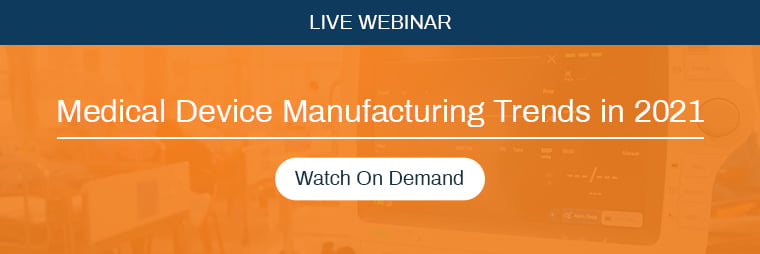For the healthcare industry, the year 2020 was one of the most demanding ones in recent memory. But the medical device sector did not buckle under the pressure the pandemic created. Instead, it rose to this unprecedented challenge by arresting the dip in its growth to a single-digit figure.
To quote a leading global market research and intelligence company, 'The market was expected to decline from $456.9 billion in 2019 to $442.5 billion in 2020 at a rate of -3.2%, mainly due to lockdowns imposed by governments across the world that hindered the supply chain in the medical device manufacturing industry. The medical device market is expected to recover and grow at a CAGR of 6.1% from 2021 and reach $603.5 billion in 2023.'
The global medical device market has been growing since 2015 at a CAGR of 5.4% and is expected to touch the $612.7 billion figure by 2025—despite the disruptions the pandemic created in 2020 and beyond. Against this backdrop, medical manufacturing companies might have to adjust their priorities for this year to keep their growth momentum intact.
In this blog, we have listed the top four medical device manufacturing industry trends we expect to see in the year 2021:
1. Extensive use of Robotics:
The past decade has given rise to non-invasive and minimally invasive robotic systems like the Cyber knife, Gamma knife, and the da Vinci surgical robot becoming integral parts of surgical procedures. These robotic delivery systems' success has propelled a rise in demand for minimally invasive robotic surgery (MIRS). Such is the demand for these devices that from a market size of $5.5 billion in 2018, it is expected to grow to $24 billion by 2025.
Apart from surgeries, robots are also used to assist patients with post-surgical rehabilitation, automate research laboratories, and disinfect clinics and hospitals — an imperative during COVID-19.

Robotic surgeries are preferred by doctors and patients alike. While surgeons enjoy the precision, efficiency, control, and better ergonomics robotics provide, patients favor the smaller incisions, shorter recovery period, decreased blood loss, and reduced hospital stay that these minimally invasive procedures offer.
With an increasing demand for microbots and nanotechnology, medical device manufacturing companies need to actively focus on these areas. Such accelerated growth and demand in robotics call for medical manufacturing enterprises to boost their research and development efforts in this field.
2. The Internet of Medical Things (IoMT):
The Internet of Medical Things (IoMT) is a vital part of the digital transformation in the medical device industry. IoMT has revolutionized medical devices with top-notch innovations— smart devices, lightweight communication devices and smart sensors. With effective monitoring of biomedical signals and disease diagnoses without human intervention, this technology has been helping healthcare companies reduce costs, enhance efficiency, and improve patient outcomes.
The IoMT market size is expected to grow to $285.5 billion by 2029. By integrating IoMT with critical medical devices, manufacturers can improve data collection and its utilization to help healthcare providers make informed decisions.
3. A need to boost cybersecurity
As the innovation and use of technology in medical devices increases, so will the threat of cyberattacks. The exponential increase in information exchange between healthcare providers is pressing manufacturers to build secured, error-free devices. A key step manufacturers must take while doing so is ensure continuous updates happen to safeguard the data from sophisticated cyberattacks. Large corporations may be able to keep up with these security requirements, but mid-sized and/ or smaller companies are bound to find this challenging.
The criticality of the matter is illustrated by the fact that even the FDA has recognized the shared responsibility that medical device companies have to create a secure medical device ecosystem to efficiently handle cybersecurity risks.
4. Accelerated use of Artificial Intelligence (AI):
Although Artificial Intelligence (AI) is a familiar concept for medical device companies, its use and prevalence are expected to become more advanced and frequent in 2021. By helping in diagnosis, identifying trends and creating efficiencies, AI and Machine Learning (ML) have been key drivers of digital transformation in the healthcare sector.
The potential of Machine Learning and AI has also been recognized by the FDA — resulting in it introducing a set of guidelines for developing digital medical device. In 2021, medical device needs to prioritize targeted treatments for patients and personalized medicine by leveraging these technologies.
The four medical device trends we have detailed in this blog are forecast to drive innovation and growth in this sector in 2021 and for a few years to come. Learn how medical device companies are optimizing their operations through Mach Medical's success story.

